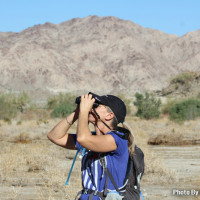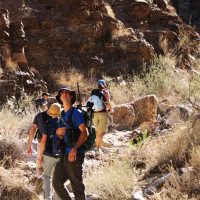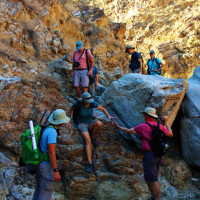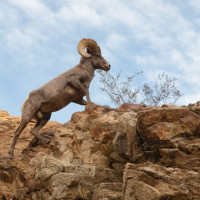
Advocating For The Preservation Of Desert Wildlife Since 1982
By Esther Sanchez
For many decades, the Coachella Valley has been a true hotbed of philanthropic work of all sorts and we at CV Weekly pride ourselves on doing everything we can to highlight, support and bring awareness to the many truly crucial, non-profit organizations that have developed throughout the history of our beloved valley. As important and well-deserving as any of the many local charity organizations that have taken root in the desert are, the Bighorn Institute is doing incredible work that is vital to the preservation of some of the most magnificent creatures that have made the desert their home and that is why they deserve all of our recognition and support.
Nearly 35 years ago, James R. DeForge, executive director and research biologist for the Institute, with the help of like-minded biologists and veterinarians founded the organization that has become the literal savior of the once, perilously endangered population of Peninsular bighorn sheep. These noble, yet typically elusive animals have evolved to be able to skillfully negotiate the most daunting terrain imaginable…surviving and at times, thriving through some the harshest of environmental circumstances this planet can throw at them. Like the indigenous plant life we often take for granted…cacti species that push their way through the tiniest cracks in the unforgiving, rocky ranges of the Santa Rosa, Anza-Borrego and San Jacinto Mountains where water is the scarcest of commodities….the bighorn sheep have survived under what seems to be the bare minimum of resources.
I was lucky enough to be invited by my friend and Bighorn Institute biologist, Marcus Nelson, to accompany a group of really cool folks who are members of the Institute on a hike in the exquisite, Carrizo Canyon to scan the peaks in hopes of spotting some of these shy, ninjas of the desert. The Institute hosts such events periodically during season.
Institute members and fellow hiker, Ann Wride (who supplied CV Weekly with some spectacular photos she took of the sheep on previous hikes): “My husband, Evan and I have been members for several years. We spend several months every winter here in the desert as we are from San Luis Obispo, California. We are lovers of wildlife and enjoy supporting groups who are successful at reintroducing species to the wild like the Bighorn Institute has done. They have successfully released over a hundred sheep into these local mountains. It is always a thrill to see one of the sheep or any wildlife in the pristine nature that surrounds the Coachella Valley. We love to hike and are always excited when we see one of the sheep. It’s an added bonus for us hikers.”
The fun and informative hike was led by associate director and biologist, Aimee Byard along with biologists Marcus Nelson and Bo Westerfield, who sported antenna devices that monitor particular sheep who have been collared for tracking purposes. They can follow a signal that, if they are lucky, will lead them to the sheep. As was explained to me on the hike, the signal alerts the biologists if and when the collared animal is immobile for more than four hours in which case there is a probability that the animal might be sick or has passed.
I learned so much on journey about the animals themselves that I never would have known before. Even more so, I was incredibly impressed by the daunting and thankless work these biologists do on a daily basis for these animals. It’s one thing to take a leisurely hike with a fun group of like-minded patrons through a beautiful canyon on a lovely fall day in 75 degree weather. But, the reality is that their job requires them to track miles into unforgiving areas that none of us are ever likely see, regardless of the temperature. They do this because it is necessary work to maintain the survival of the bighorn population that at one point nearly disappeared.
Man-made development that has encroached on their territory, climate changes that have dried up their water sources, infections and diseases transmitted through non-indigenous livestock and the introduction of non-indigenous plant life that is often toxic to the sheep are just a few of the reasons why our local population of bighorn sheep have at times, teetered on the brink of extinction. The thankless work of the good folks at the institute, in cooperation with local donors, the California Department of Fish and Game, U.S. Fish and Wildlife Service, and the Bureau of Land Management are the sole reason why extinction is not currently inevitable for the sheep.
I am thankful to have had my eyes opened to the reality of how we, as residents and arguably, invaders…have done to cause harm to our local wildlife populations and even more importantly, what we can do to protect them. Restrictions of certain areas from human traffic, particularly during lambing season is definitely one of the key issues. I must admit. I myself have been guilty on numerous occasions in the past of hiking up to an area on a trail where a sign has been posted to restrict further access and ignored it completely while arrogantly thinking to myself, “Screw the man!” The wealth of information I gained on our hike has made me think differently about those barriers.
In fact, according to the Institute biologists, strategically erecting barriers at the request of the foundation due to cooperation of some local city governments in recent years has proven even more successful to the growth of the local bighorn population than originally projected. In 2002 the city of Rancho Mirage erected a 4.5 mile fence that has been credited in helping the local sheep population. The city also maintains artificial water sources in the mountains and requires developments in the foothills to install fences. These simple tools have brought the herds in the area back from the golf-courses, roadsides and country club streets to the habitat where they belong.
In February of 2014, state and federal wildlife agencies notified La Quinta city officials and the Coachella Valley Conservation Commission that, because sheep had been coming into the community, a barrier would have to be installed within two years. This has yet to happen and the conservation commission is conducting an environmental analysis of alternatives for keeping the sheep out of golf courses and neighborhoods in La Quinta.
I encourage every citizen of the Coachella Valley to educate themselves on the continuing plight of conserving the nature that surrounds us and support agencies such as the Bighorn Institute. Membership costs start at a mere $25 on up. Their website has a wealth of great info on simple things we all can do to help.
















































